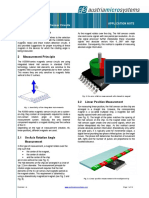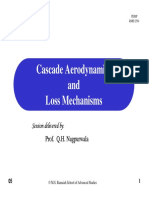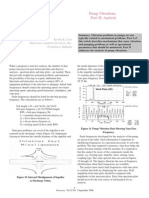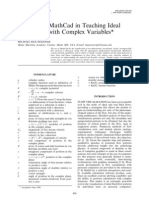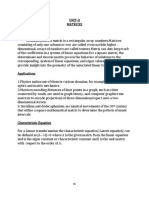Moment of Inertia
Moment of Inertia
Uploaded by
Rahmatullah RahmatCopyright:
Available Formats
Moment of Inertia
Moment of Inertia
Uploaded by
Rahmatullah RahmatCopyright
Available Formats
Share this document
Did you find this document useful?
Is this content inappropriate?
Copyright:
Available Formats
Moment of Inertia
Moment of Inertia
Uploaded by
Rahmatullah RahmatCopyright:
Available Formats
Moment of inertia - Wikipedia, the free encyclopedia
Page 1 of 13
Moment of inertia
From Wikipedia, the free encyclopedia
This article is about the moment of inertia of a rotating object. For the moment of inertia dealing with the bending of a beam, see second moment of area or area moment of inertia. In classical mechanics, moment of inertia, also called mass moment of inertia, rotational inertia, polar moment of inertia of mass, or the angular mass, (SI units kgm) is a measure of an object's resistance to changes to its rotation. It is the inertia of a rotating body with respect to its rotation. The moment of inertia plays much the same role in rotational dynamics as mass does in linear dynamics, describing the relationship between angular momentum and angular velocity, torque and angular acceleration, and several other quantities. The symbol I and sometimes J are usually used to refer to the moment of inertia or polar moment of inertia. While a simple scalar treatment of the moment of inertia suffices for many situations, a more advanced tensor treatment allows the analysis of such complicated systems as spinning tops and gyroscopic motion. The concept was introduced by Leonhard Euler in his book Theoria motus corporum solidorum seu rigidorum in 1765. [1] In this book, he discussed the moment of inertia and many related concepts, such as the principal axis of inertia.
Classical mechanics
Newton's Second Law
History of classical mechanics Timeline of classical mechanics Branches Statics Dynamics / Kinetics Kinematics Applied mechanics Celestial mechanics Continuum mechanics Statistical mechanics Formulations Newtonian mechanics (Vectorial mechanics) Analytical mechanics: Lagrangian mechanics Hamiltonian mechanics Fundamental concepts Space Time Velocity Speed Mass Acceleration Gravity Force Impulse Torque / Moment / Couple Momentum Angular momentum Inertia Moment of inertia Reference frame Energy Kinetic energy Potential energy Mechanical work Virtual work D'Alembert's principle Core topics Rigid body Rigid body dynamics Euler's equations (rigid body dynamics) Motion Newton's laws of motion Newton's law of universal gravitation Equations of motion Inertial frame of reference Non-inertial reference frame Rotating reference frame Fictitious force Linear motion
Contents
1 Overview 2 Scalar moment of inertia for single body 3 Scalar moment of inertia for many bodies 3.1 Moment of Inertia Theorems 3.2 Properties 3.3 Energy, Angular Momentum, Torque 3.4 Examples 4 Moment of inertia tensor 4.1 Definition 4.2 Derivation of the tensor components 4.3 Reduction to scalar 5 Principal axes of inertia
http://en.wikipedia.org/wiki/Moment_of_inertia
11/07/2011
Moment of inertia - Wikipedia, the free encyclopedia
Page 2 of 13
5.1 Parallel axis theorem 5.2 Rotational symmetry 5.3 Comparison with covariance matrix 6 See also 7 Notes 8 References 9 External links
Overview
The moment of inertia of an object about a given axis describes how difficult it is to change its angular motion about that axis. Therefore, it encompasses not just how much mass the object has overall, but how far each bit of mass is from the axis. The farther out the object's mass is, the more rotational inertia the object has, and the more force is required to change its rotation rate. For example, consider two hoops, A and B, made of the same material and of equal mass. Hoop A is larger in diameter but thinner than B. It requires more effort to accelerate hoop A (change its angular velocity) because its mass is distributed farther from its axis of rotation: mass that is farther out from that axis must, for a given angular velocity, move more quickly than mass closer in. So in this case, hoop A has a larger moment of inertia than hoop B.
Mechanics of planar particle motion Displacement (vector) Relative velocity Friction Simple harmonic motion Harmonic oscillator Vibration Damping Damping ratio Rotational motion Circular motion Uniform circular motion Non-uniform circular motion Centripetal force Centrifugal force Centrifugal force (rotating reference frame) Reactive centrifugal force Coriolis force Pendulum Rotational speed Angular acceleration Angular velocity Angular frequency Angular displacement Scientists Galileo Galilei Isaac Newton Jeremiah Horrocks Leonhard Euler Jean le Rond d'Alembert Alexis Clairaut Joseph Louis Lagrange Pierre-Simon Laplace William Rowan Hamilton Simon-Denis Poisson
The moment of inertia of an object can change if its shape changes. Figure skaters who begin a spin with arms outstretched provide a striking example. By pulling in their arms, they reduce their moment of inertia, causing them to spin faster (by the conservation of angular momentum). The moment of inertia has two forms, a scalar form, I, (used when the axis of rotation is specified) and a more general tensor form that does not require the axis of rotation to be specified. The scalar moment of inertia, I, (often called simply the "moment of inertia") allows a succinct analysis of many simple Divers reducing their moments of problems in rotational dynamics, such as objects rolling down inertia to increase their rates of inclines and the behavior of pulleys. For instance, while a block rotation of any shape will slide down a frictionless decline at the same rate, rolling objects may descend at different rates, depending on their moments of inertia. A hoop will descend more slowly than a solid disk of equal mass and radius because more of its mass is located far from the axis of rotation. However, for (more complicated) problems in which the axis of rotation can change, the scalar treatment is inadequate, and the tensor treatment must be used (although shortcuts are possible in special situations). Examples requiring such a treatment include gyroscopes, tops, and even satellites, all objects whose alignment can change.
http://en.wikipedia.org/wiki/Moment_of_inertia
11/07/2011
Moment of inertia - Wikipedia, the free encyclopedia
Page 3 of 13
The moment of inertia is also called the mass moment of inertia (especially by mechanical engineers) to avoid confusion with the second moment of area, which is sometimes called the area moment of inertia (especially by structural engineers). The easiest way to differentiate these quantities is through their units (kgm as opposed to m4). In addition, moment of inertia should not be confused with polar moment of inertia (more specifically, polar moment of inertia of area), which is a measure of an object's ability to resist torsion (twisting) only, although, mathematically, they are similar: if the solid for which the moment of inertia is being calculated has uniform thickness in the direction of the rotating axis, and also has uniform mass density, the difference between the two types of moments of inertia is a factor of mass per unit area.
Scalar moment of inertia for single body
Consider a rigid light rod of length L with a point mass m at one end and pivoted at the other end. Suppose the rod rotates about its pivot at a constant rate so that the mass moves at speed v. Then the kinetic energy T of the mass is:
Using v =
L, where is the angular velocity in radians per second, one obtains:
which can be rearranged to give:
This equation resembles the original expression for the kinetic energy, but in the place of the linear 2 2 velocity v is the angular velocity , and instead of the mass m is mL . The quantity mL can therefore be seen as an analogue of mass for rotational motion; in other words, it is a measure of rotational inertia.
Scalar moment of inertia for many bodies
Consider a rigid body rotating with angular velocity around a certain axis. The body consists of N point masses mi whose distances to the axis of rotation are denoted ri. Each point mass will have the speed vi = ri, so that the total kinetic energy T of the body can be calculated as
In this expression the quantity in parentheses is called the moment of inertia of the body (with respect to the specified axis of rotation). It is a purely geometric characteristic of the object, as it depends only on its shape and the position of the rotation axis. The moment of inertia is usually denoted with the capital letter I:
http://en.wikipedia.org/wiki/Moment_of_inertia
11/07/2011
Moment of inertia - Wikipedia, the free encyclopedia
Page 4 of 13
It is worth emphasizing that ri here is the distance from a point towards the axis of rotation, not towards the origin. As such, the moment of inertia will be different when considering rotations about different axes. Similarly, the moment of inertia of a continuous solid body rotating about a known axis can be calculated by replacing the summation with the integral:
where r is the radius vector of a point within the body, (r) is the mass density at point r, and d(r) is the distance from point r to the axis of rotation. The integration is evaluated over the volume V of the body.
Moment of Inertia Theorems
Calculations for the MOI of a body are not easy in general. The process can be simplified in the following ways: Choosing axes to take advantage of geometric symmetries Physical homeogeneity (i.e uniform mass distribution) making the density function (r) become constant (elementary calculations, or generally an approximation) Use of the following theorems [2], see below for details. Theorem Nomenclature Equation
Superposition Principle for I = Resultant MOI (about any one axis) MOI about any chosen Axis net M = Total mass of body d = Perpendicular distance from an axis through the COM to another parallel axis ICOM = MOI about the axis through the COM I = MOI about the parallel axis i, j, k refer to MOI about any three mutually Perpendicular axis theorem perpendicular axes. The sum of MOI about any two is greater than or equal to the third.
Parallel axis theorem
Properties
Superposition
http://en.wikipedia.org/wiki/Moment_of_inertia
11/07/2011
Moment of inertia - Wikipedia, the free encyclopedia
Page 5 of 13
The moment of inertia of the body is additive. That is, if a body can be decomposed (either physically or conceptually) into several constituent parts, then the moment of inertia of the whole body about a given axis is equal to the sum of moments of inertia of each part around the same axis.[3] Basing just on the dimensional analysis, the moment of inertia must take the form I = cML2, where M is the mass, L is the size of the body in the direction perpendicular to the axis of rotation, and c is a is called the radius of gyration of dimensionless inertial constant. Additionally, the length the body. Perpendicular Axes If Ix, Iy, Iz are moments of inertia around three perpendicular axes passing through the bodys center of mass, then each of them cannot be greater than the sum of two others: for example Iz Ix + Iy. Here the equality holds only if the body is flat and located in the Oxy coordinate plane. Parallel Axes If the objects moment of inertia ICOM around a certain axis passing through the center of mass is known, then the parallel axis theorem or Huygens-Steiner theorem provides a convenient formula to compute the moment of inertia Id of the same body around a different axis, which is parallel to the original and located at a distance d from it. The formula is only suitable when the initial and final axes are parallel. In order to compute the moment of inertia about an arbitrary axis, one has to use the objects moment of inertia tensor.
Energy, Angular Momentum, Torque
The rotational kinetic energy of a rigid body with angular velocity (in radians per second) is expressed in terms of the objects moment of inertia:
This formula is similar to the translational kinetic energy Et = mv2. Thus, the moment of inertia I plays the role of mass in the rotational dynamics. One key difference between the mass and the (scalar) moment of inertia is that the latter depends on the axis rotation and so is not truly invariant. The invariant characteristic of the body in rotational motion is the tensor of moment of inertia I, defined later. The angular momentum of the body rotating around one of its principal axis is also proportional to the moment of inertia:
This expression is parallel to the formula for translational momentum p = mv, where the moment of inertia I plays the role of mass m, and the angular velocity stands for the velocity v. The scalar formula is valid for rotations around one of the principal axes of the body or for rotation about any fixed axis. The equivalent formula involving the tensor moment of inertia is always correct and must be used in cases of free rotation about a non-principal axis.
http://en.wikipedia.org/wiki/Moment_of_inertia
11/07/2011
Moment of inertia - Wikipedia, the free encyclopedia
Page 6 of 13
Also when the body rotates around one of its principal axes, and the direction of the axis of rotation remains constant, one can relate the torque on an object and its angular acceleration in a similar equation:
where is the torque and is the angular acceleration.
Examples
Main article: List of moments of inertia Diatomic molecule, with atoms m1 and m2 at a distance d from each other, rotating around the axis which passes through the molecules center of mass and is perpendicular to the direction of the molecule. The easiest way to calculate this molecules moment of inertia is to use the parallel axis theorem. If we consider rotation around the axis passing through the atom m1, then the moment of inertia will be I1 = m10 + m2d 2 = m2d 2. On the other hand, by the parallel axis theorem this moment is equal to I1 = I + (m1 + m2)a2, where I is the moment of inertia around the axis passing through the center of mass, and a is the distance between the center of mass and the first atom. By the center of mass formula, this distance is equal to a = m2d / (m1 + m2). Thus,
Thin rod of mass m and length , rotating around the axis which passes through its center and is perpendicular to the rod. Let Oz be the axis of rotation, and Ox the axis along the rod. If is the density, and s the cross-section of the rod (so that m = s), then the volume element for the integral formula will be equal to dV = sdx, where x changes from to . The moment of inertia can be found by computing the integral:
Solid ball of mass m and radius R, rotating around an axis which passes through the center. Suppose Oz is the axis of rotation. The distance from point r = (x,y,z) towards the axis Oz is equal to d(r)2 = x2 + y2. Thus, in order to compute the moment of inertia Iz, we need to evaluate the integral (x2 + y2) dV. The calculation considerably simplifies if we notice that by symmetry of the problem, the moments of inertia around all axes are equal: Ix = Iy = Iz. Then
http://en.wikipedia.org/wiki/Moment_of_inertia
11/07/2011
Moment of inertia - Wikipedia, the free encyclopedia
Page 7 of 13
where r2 = x2 + y2 + z2 is the distance from point r to the origin. This integral is easy to evaluate in the spherical coordinates, the volume element will be equal to dV = 4r2dr, where r goes from 0 to R. Thus,
In mechanics of machines, when designing rotary parts like gears, pulleys, shafts, couplings etc., which are used to transmit torques the moment of inertia, have to be considered. The moment of inertia is given about an axis and it depends on the shape, density of a rotating element. When considering mechanisms like gear trains, worm and wheel, where there are more than one rotating element, more than one axis of rotation, an equivalent moment of inertia for the system should be found. Practically when a geared system is enclosed, equivalent moment of inertia can be measured by measuring the angular acceleration for a known torque or theoretically it can be estimated when the masses and dimensions of the rotating elements and shafts are known. In this practical the equivalent moment of inertia of a worm and wheel system is measured using above mention methods.
Moment of inertia tensor
In three dimensions, if the axis of rotation is not given, we need to be able to generalize the scalar moment of inertia to a quantity that allows us to compute a moment of inertia about arbitrary axes. This quantity is known as the moment of inertia tensor and can be represented as a symmetric positive semi -definite matrix, I. This representation elegantly generalizes the scalar case: The angular momentum vector is related to the rotation velocity vector by
and the kinetic energy is given by
as compared with
in the scalar case. Like the scalar moment of inertia, the moment of inertia tensor may be calculated with respect to any point in space, but for practical purposes, the center of mass is almost always used. In general, its components are time dependent.
Definition
For a rigid object of N point masses mk, the moment of inertia tensor (with respect to the origin) has components given by
http://en.wikipedia.org/wiki/Moment_of_inertia
11/07/2011
Moment of inertia - Wikipedia, the free encyclopedia
Page 8 of 13
where
and I12 = I21, I13 = I31, and I23 = I32. (Thus I is a symmetric tensor.) Note that the scalars Iij with are called the products of inertia. Here Ixx denotes the moment of inertia around the x-axis when the objects are rotated around the x-axis, Ixy denotes the moment of inertia around the y-axis when the objects are rotated around the x-axis, and so on. These quantities can be generalized to an object with distributed mass, described by a mass density function, in a similar fashion to the scalar moment of inertia. One then has
In more-concise notation:
http://en.wikipedia.org/wiki/Moment_of_inertia
11/07/2011
Moment of inertia - Wikipedia, the free encyclopedia
Page 9 of 13
where is the vector from the center of mass to a point in the volume, V and is their outer product, E3 is the 3 3 identity matrix, and V is a region of space completely containing the object. Alternatively, the above can be described in Einstein notation as:
The diagonal elements of I are called the principal moments of inertia. As is clear from the definition, I and its components are in general time-dependent. They are constant only if calculated in a reference frame moving rigidly with the rigid body. On the other hand, the eigenvalues I are invariant, that is independent of the reference frame used to calculate I.
Derivation of the tensor components
The distance r of a particle at from the axis of rotation passing through the origin in the direction is 2 . By using the formula I = mr (and some simple vector algebra) it can be seen that the moment of inertia of this particle (about the axis of rotation passing through the origin in the This is a quadratic form in and, after a bit more direction) is algebra, this leads to a tensor formula for the moment of inertia
This is exactly the formula given below for the moment of inertia in the case of a single particle. For multiple particles we need only recall that the moment of inertia is additive in order to see that this formula is correct.
Reduction to scalar
For any axis , represented as a column vector with elements ni, the scalar form I can be calculated from the tensor form I as
The range of both summations correspond to the three Cartesian coordinates. The following equivalent expression avoids the use of transposed vectors which are not supported in maths libraries because internally vectors and their transpose are stored as the same linear array,
However it should be noted that although this equation is mathematically equivalent to the equation above for any matrix, inertia tensors are symmetrical. This means that it can be further simplified to:
http://en.wikipedia.org/wiki/Moment_of_inertia
11/07/2011
Moment of inertia - Wikipedia, the free encyclopedia
Page 10 of 13
Principal axes of inertia
By the spectral theorem, since the moment of inertia tensor is real and symmetric, there exists a Cartesian coordinate system in which it is diagonal, having the form
where the coordinate axes are called the principal axes and the constants I1, I2 and I3 are called the principal moments of inertia. This result was first shown by J. J. Sylvester (1852), and is a form of Sylvester's law of inertia. The principal axis with the highest moment of inertia is sometimes called the figure axis or axis of figure. When all principal moments of inertia are distinct, the principal axes through center of mass are uniquely specified. If two principal moments are the same, the rigid body is called a symmetrical top and there is no unique choice for the two corresponding principal axes. If all three principal moments are the same, the rigid body is called a spherical top (although it need not be spherical) and any axis can be considered a principal axis, meaning that the moment of inertia is the same about any axis. The principal axes are often aligned with the object's symmetry axes. If a rigid body has an axis of symmetry of order m, i.e., is symmetrical under rotations of 360/m about a given axis, the symmetry axis is a principal axis. When m > 2, the rigid body is a symmetrical top. If a rigid body has at least two symmetry axes that are not parallel or perpendicular to each other, it is a spherical top, e.g., a cube or any other Platonic solid. The motion of vehicles is often described about these axes with the rotations called yaw, pitch, and roll. A practical example of this mathematical phenomenon is the routine automotive task of balancing a tire, which basically means adjusting the distribution of mass of a car wheel such that its principal axis of inertia is aligned with the axle so the wheel does not wobble.
Parallel axis theorem
Main article: Parallel axis theorem Once the moment of inertia tensor has been calculated for rotations about the center of mass of the rigid body, there is a useful labor-saving method to compute the tensor for rotations offset from the center of mass. If the axis of rotation is displaced by a vector R from the center of mass, the new moment of inertia tensor equals
where m is the total mass of the rigid body, E3 is the 3 3 identity matrix, and
is the outer product.
http://en.wikipedia.org/wiki/Moment_of_inertia
11/07/2011
Moment of inertia - Wikipedia, the free encyclopedia
Page 11 of 13
Rotational symmetry
Using the above equation to express all moments of inertia in terms of integrals of variables either along or perpendicular to the axis of symmetry usually simplifies the calculation of these moments considerably.
Comparison with covariance matrix
Main article: Moment (mathematics) The moment of inertia tensor about the center of mass of a 3 dimensional rigid body is related to the covariance matrix of a trivariate random vector whose probability density function is proportional to the pointwise density of the rigid body by:[citation needed]
where n is the number of points. The structure of the moment-of-inertia tensor comes from the fact that it is to be used as a bilinear form on rotation vectors in the form
Each element of mass has a kinetic energy of
The velocity of each element of mass is where r is a vector from the center of rotation to that element of mass. The cross product can be converted to matrix multiplication so that
and similarly
Thus,
plugging in the definition of
the
term leads directly to the structure of the moment tensor.
See also
List of moments of inertia List of moment of inertia tensors Rotational energy
http://en.wikipedia.org/wiki/Moment_of_inertia
11/07/2011
Moment of inertia - Wikipedia, the free encyclopedia
Page 12 of 13
Parallel axis theorem Perpendicular axis theorem Stretch rule Tire balance Poinsot's ellipsoid Instant centre of rotation
Notes
1. ^ Euler, Leonhard (1765-01-01) (in Latin), Theoria motus corporum solidorum seu rigidorum: Ex primis nostrae cognitionis principiis stabilita et ad omnes motus, qui in huiusmodi corpora cadere possunt, accommodata, Cornell University Library, ISBN 978-1429742818 2. ^ 3000 Solved Problems in Physics, Schaum Series, A. Halpern, Mc Graw Hill, 1988, ISBN 9-780070257344 3. ^ Mass moment of inertia by Mehrdad Negahban, University of Nebraska (http://emntserver.unl.edu/NEGAHBAN/EM223/note18/note18.htm)
References
Goldstein, H. (1980), Classical Mechanics (2nd ed.), Addison-Wesley, ISBN 0-201-02918-9. Landau, LD; Lifshitz (1976), Mechanics (3rd ed.), Pergamon Press, ISBN 0-080-21022-8 (hardcover); ISBN 0-080-29141-4 (softcover). Marion, JB; Thornton, ST. (1995), Classical Dynamics of Systems and Particles (4th ed.), Thomson, ISBN 0-030-97302-3. Sylvester, J J (1852), "A demonstration of the theorem that every homogeneous quadratic polynomial is reducible by real orthogonal substitutions to the form of a sum of positive and negative squares" (http://www.maths.ed.ac.uk/~aar/sylv/inertia.pdf) , Philosophical Magazine IV: 138142, http://www.maths.ed.ac.uk/~aar/sylv/inertia.pdf, retrieved 2008-06-27 Symon, KR (1971), Mechanics (3rd ed.), Addison-Wesley, ISBN 0-201-07392-7. Tenenbaum, RA (2004), Fundamentals of Applied Dynamics, Springer, ISBN 0-387-00887-X.
External links
Angular momentum and rigid-body rotation in two and three dimensions (http://www.lightandmatter.com/html_books/0sn/ch04/ch04.html) Lecture notes on rigid-body rotation and moments of inertia (http://hyperphysics.phyastr.gsu.edu/hbase/mi.html) The moment of inertia tensor (http://kwon3d.com/theory/moi/iten.html) An introductory lesson on moment of inertia: keeping a vertical pole not falling down (Java simulation) (http://www.phy.hk/wiki/englishhtm/Balance.htm) Tutorial on finding moments of inertia, with problems and solutions on various basic shapes (http://hypertextbook.com/physics/mechanics/rotational-inertia/) Retrieved from "http://en.wikipedia.org/wiki/Moment_of_inertia" Categories: Fundamental physics concepts | Introductory physics | Mechanics | Physical quantities | Rigid bodies | Tensors | Rotation This page was last modified on 11 July 2011 at 07:16. Text is available under the Creative Commons Attribution-ShareAlike License; additional terms may apply. See Terms of use for details.
http://en.wikipedia.org/wiki/Moment_of_inertia
11/07/2011
Moment of inertia - Wikipedia, the free encyclopedia
Page 13 of 13
Wikipedia is a registered trademark of the Wikimedia Foundation, Inc., a non-profit organization.
http://en.wikipedia.org/wiki/Moment_of_inertia
11/07/2011
You might also like
- ch5 Weather Trig ApplicationDocument5 pagesch5 Weather Trig Applicationapi-488084761No ratings yet
- FifaDocument10 pagesFifaPunit SardaNo ratings yet
- Aerodynamics Lab ManualDocument50 pagesAerodynamics Lab Manualshibin874141No ratings yet
- Static and Dynamic Balancing of Rigid RotorsDocument29 pagesStatic and Dynamic Balancing of Rigid Rotorsاحمد شوقي عمارNo ratings yet
- Anatomy of Industrial RobotsDocument3 pagesAnatomy of Industrial Robotstechfi0% (1)
- Assignment ClutchDocument624 pagesAssignment ClutchSubhash KNo ratings yet
- Axial Fan NotchDocument3 pagesAxial Fan NotchhahasiriusNo ratings yet
- Electromagnetic ClutchDocument4 pagesElectromagnetic ClutchKunal PatidarNo ratings yet
- Lecture Slides: Shigley's Mechanical Engineering DesignDocument108 pagesLecture Slides: Shigley's Mechanical Engineering DesignHamza SultanNo ratings yet
- Derivation of Induction Motor Induced Torque EquationDocument31 pagesDerivation of Induction Motor Induced Torque Equationmalik karim dadNo ratings yet
- Applied Mecanics Lab ManualDocument52 pagesApplied Mecanics Lab ManualHasnain BukhariNo ratings yet
- ClutchDocument14 pagesClutchArt DoeNo ratings yet
- Drive Shaft - WikipediaDocument5 pagesDrive Shaft - WikipediaMohsen SharifNo ratings yet
- Design and Analysis of An Epicyclic Gearbox For An Electric DrivetrainDocument9 pagesDesign and Analysis of An Epicyclic Gearbox For An Electric DrivetrainNajrul IslamNo ratings yet
- Fluid Mechanics Laboratory: Laboratory 06.2: Gear Pump Test RigDocument5 pagesFluid Mechanics Laboratory: Laboratory 06.2: Gear Pump Test RigRitu GavasaneNo ratings yet
- Principles of Chemistry - Fundamentals of ThermodynamicsDocument64 pagesPrinciples of Chemistry - Fundamentals of Thermodynamicsred velvetNo ratings yet
- MdesignDocument24 pagesMdesigncosta59dac9242100% (1)
- TurbomachineryDocument53 pagesTurbomachineryasp9924No ratings yet
- Types of BeltsDocument5 pagesTypes of BeltsMichael Huffman50% (2)
- Solenoids and RelaysDocument15 pagesSolenoids and RelaysJayloyd LaraNo ratings yet
- General Description: Magnet Selection Guide Application NoteDocument15 pagesGeneral Description: Magnet Selection Guide Application NotesekoNo ratings yet
- Belt DrivesDocument35 pagesBelt Drives222Gaurav AherNo ratings yet
- A SEMINAR ON AERODYNAMICS IN CarsDocument28 pagesA SEMINAR ON AERODYNAMICS IN CarsParth MaldhureNo ratings yet
- Four Stroke EngineDocument9 pagesFour Stroke Enginepawarsikander100% (3)
- ActuatorsDocument17 pagesActuatorsGururaj GadadNo ratings yet
- Design and Analysis of Disc Brake and Caliper of Four WheelerDocument5 pagesDesign and Analysis of Disc Brake and Caliper of Four WheelerIJSTENo ratings yet
- ClutchDocument44 pagesClutchdude_udit321771No ratings yet
- Design of Permanent Magnet Systems Using Finite Element AnalysisDocument5 pagesDesign of Permanent Magnet Systems Using Finite Element AnalysiselectronenergyNo ratings yet
- 05-PT11-Cascade Aerodynamics (Compatibility Mode)Document45 pages05-PT11-Cascade Aerodynamics (Compatibility Mode)Venkat Pavan100% (1)
- Dynamic Analysis Using FEADocument19 pagesDynamic Analysis Using FEANallathambiNo ratings yet
- Technical English I: Guillermo Duran SalazarDocument12 pagesTechnical English I: Guillermo Duran SalazarGuillermo duranNo ratings yet
- Dynamometer: Types of Dynamometers: There Are Mainly Two Types of DynamometersDocument11 pagesDynamometer: Types of Dynamometers: There Are Mainly Two Types of DynamometersKumar BabuNo ratings yet
- Design of CouplingDocument18 pagesDesign of CouplingHarikrishna ShenoyNo ratings yet
- Simone Mola - Fundamentals of Vehicle DynamicsDocument353 pagesSimone Mola - Fundamentals of Vehicle DynamicsWagner AbreuNo ratings yet
- EM 81 - Pump Vibrations Part IIDocument2 pagesEM 81 - Pump Vibrations Part IIΡαφαηλ Καμ.100% (1)
- Potential FlowsDocument13 pagesPotential FlowsJuan Gonzalez100% (1)
- 1 ADocument27 pages1 AAtilio Suàrez BardellineNo ratings yet
- Simple and Compound Gear TrainDocument2 pagesSimple and Compound Gear TrainHendri Yoga SaputraNo ratings yet
- Rtiwari 02Document115 pagesRtiwari 02Idabagus Putu Putra MahartanaNo ratings yet
- Geometric Progression of Gear RatiosDocument2 pagesGeometric Progression of Gear RatiosSelva Kumar0% (2)
- Klein Technical GuidelineDocument21 pagesKlein Technical GuidelinePeter100% (2)
- Power Units and TransmissionDocument42 pagesPower Units and TransmissionAmarjeet RaiNo ratings yet
- Gear Production Suite BrochureDocument8 pagesGear Production Suite BrochureDontyneSystems100% (1)
- Bearing Selection: IntrdouctionDocument4 pagesBearing Selection: IntrdouctionMuneeb JavedNo ratings yet
- Bearings JournalDocument11 pagesBearings JournalUlfa Luqman100% (1)
- Power Transmission: Rotational PulleyDocument19 pagesPower Transmission: Rotational PulleyQim SvNo ratings yet
- Numerical Gerotor DesignDocument18 pagesNumerical Gerotor Designsardhan.rajender84No ratings yet
- Design of ClutchDocument8 pagesDesign of Clutchdnp015No ratings yet
- Vibration 5 11Document20 pagesVibration 5 11Aalekh PrajapatiNo ratings yet
- Axial Thrust Load Prediciton of Centrifugal CompressorsDocument44 pagesAxial Thrust Load Prediciton of Centrifugal CompressorsTaylor100% (1)
- Dynamics Lab Manual - ME6511Document66 pagesDynamics Lab Manual - ME6511vinothNo ratings yet
- Balancing of Rotating MassesDocument8 pagesBalancing of Rotating Massesਰਮਨਦੀਪ ਸਿੰਘNo ratings yet
- Lecture-3 ScalesDocument29 pagesLecture-3 ScalesPankaj YaduNo ratings yet
- Francis - Engine Dynamics and Structural VibrationDocument19 pagesFrancis - Engine Dynamics and Structural VibrationPankajBhamareNo ratings yet
- Scotch Yoke MechanismDocument12 pagesScotch Yoke MechanismAhmad Bin SadiqNo ratings yet
- Energy Harvesting Using Mechanical Vibrations A Complete GuideFrom EverandEnergy Harvesting Using Mechanical Vibrations A Complete GuideNo ratings yet
- Structural Health MonitoringFrom EverandStructural Health MonitoringDaniel BalageasNo ratings yet
- Introductory Applications of Partial Differential Equations: With Emphasis on Wave Propagation and DiffusionFrom EverandIntroductory Applications of Partial Differential Equations: With Emphasis on Wave Propagation and DiffusionNo ratings yet
- Moment of InertiaDocument16 pagesMoment of InertiaerkarnanNo ratings yet
- Box Muller Method: 1 MotivationDocument2 pagesBox Muller Method: 1 MotivationNitish KumarNo ratings yet
- Physics 72.1 PresentationDocument20 pagesPhysics 72.1 PresentationPrecious DimacaliNo ratings yet
- Prmo Combinatorics Lec1 Assignment QuestionsDocument3 pagesPrmo Combinatorics Lec1 Assignment Questionssahiljha.220No ratings yet
- Lesson 11 9.2 Compound Interest Future ValueDocument7 pagesLesson 11 9.2 Compound Interest Future ValueSandro SerdiñaNo ratings yet
- CH 02Document40 pagesCH 02BaoYu MoZhiNo ratings yet
- Solution of Non Linear EquationsDocument22 pagesSolution of Non Linear EquationsMysha AnowarNo ratings yet
- Daa Unit1 PPTDocument243 pagesDaa Unit1 PPTdio rastongiNo ratings yet
- MATH-I U-3 SOLUN MatricesDocument94 pagesMATH-I U-3 SOLUN MatricesenergyengineersNo ratings yet
- Syllabus: Cambridge O Level Additional MathematicsDocument21 pagesSyllabus: Cambridge O Level Additional MathematicsHalima SadiqNo ratings yet
- Personal Learning Plan 2Document8 pagesPersonal Learning Plan 2api-601246427No ratings yet
- MA8151 KSN Notes - by WWW - EasyEngineering.net 1 PDFDocument407 pagesMA8151 KSN Notes - by WWW - EasyEngineering.net 1 PDFPrince100% (2)
- Sybsc (Mathematics) Subject:Mth-301: Calculus of Several Variables Question Bank AnsDocument11 pagesSybsc (Mathematics) Subject:Mth-301: Calculus of Several Variables Question Bank AnsKalyani ReniwalNo ratings yet
- Social ScienceDocument27 pagesSocial Scienceprojects_masterz0% (1)
- MAA Specimen#2Document15 pagesMAA Specimen#2nkvfdvdfNo ratings yet
- For Introduction To The Z-Transform: Chapter 9 Z-Transforms and ApplicationsDocument18 pagesFor Introduction To The Z-Transform: Chapter 9 Z-Transforms and ApplicationsAnonymous OrhjVLXO5sNo ratings yet
- A Robust Cognitive Architecture For Learning From SurprisesDocument12 pagesA Robust Cognitive Architecture For Learning From SurprisesJacob EveristNo ratings yet
- Cheenta Rmo Mock: Anushka Aggarwal 12 April 2020Document2 pagesCheenta Rmo Mock: Anushka Aggarwal 12 April 2020Ritoprovo RoyNo ratings yet
- (English) Basic Trigonometry - Sin Cos Tan (NancyPi) (DownSub - Com)Document6 pages(English) Basic Trigonometry - Sin Cos Tan (NancyPi) (DownSub - Com)Jisoo KimNo ratings yet
- PercentagesDocument92 pagesPercentagesSolisterADVNo ratings yet
- ECN 2322-Lecture 1 ClassDocument25 pagesECN 2322-Lecture 1 ClassNeil NkhomaNo ratings yet
- StatestsDocument20 pagesStatestskebakaone marumoNo ratings yet
- Soal Calculus 2020Document49 pagesSoal Calculus 2020Ferik Juliandi SetiawanNo ratings yet
- Mean Median Mode Champions SquareDocument3 pagesMean Median Mode Champions Squareabc goyalNo ratings yet
- 1.7: Linear and Absolute Value Inequalities: ExamplesDocument10 pages1.7: Linear and Absolute Value Inequalities: ExamplesMary AndersonNo ratings yet
- Module 1 Handout-1Document12 pagesModule 1 Handout-1Jaselle NamuagNo ratings yet
- On Imbedding Theorems For Besov Spaces: of Functions Defined in General RegionsDocument26 pagesOn Imbedding Theorems For Besov Spaces: of Functions Defined in General RegionsAnibal Coronel PerezNo ratings yet
- BS9 1st Term Wk3 - MathsDocument6 pagesBS9 1st Term Wk3 - MathsAntwi PhilimonNo ratings yet
- Lesson Plan in Math 7 (Q3W1-Day 1)Document6 pagesLesson Plan in Math 7 (Q3W1-Day 1)Jerry BasayNo ratings yet




















